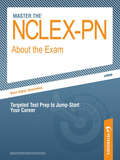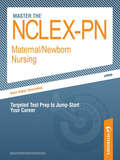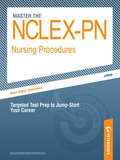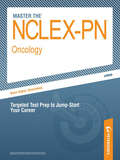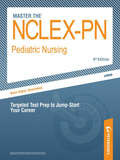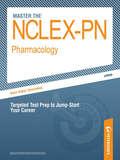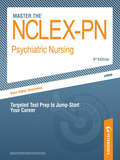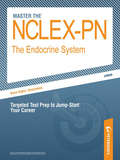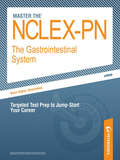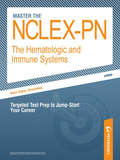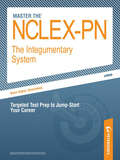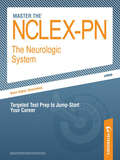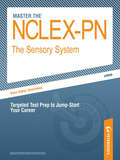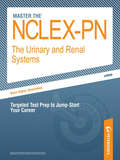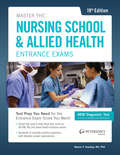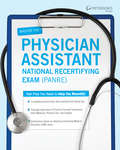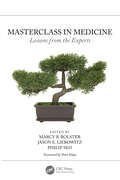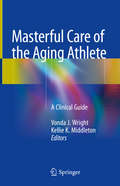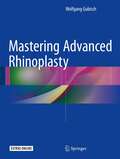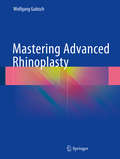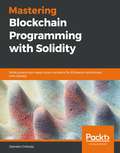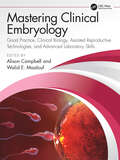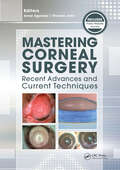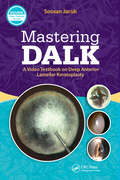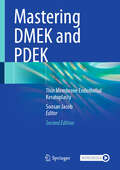- Table View
- List View
Master the NCLEX-PN: About the Exam
by Peterson'S PublicationsFind out everything you need to know about the NCLEX-PN exam, including information about practical nursing and the job outlook.<P><P> Review the NCLEX-PN Test Plan and the 4 Client Needs categories, along with overviews of each of the different question types. Learn how the exam is scored, how to make educated guesses, and how to measure your progress as you study for the exam.
Master the NCLEX-PN: Maternal/Newborn Nursing
by Peterson'S PublicationsA comprehensive review of maternal/newborn nursing concepts including anatomy, physiology, childbearing, maternal changes during pregnancy, and the signs of pregnancy. Also includes complete descriptions of the maternity process-antepartum care, labor and delivery, postpartum, and newborn care.<P><P> Includes practice exercises with complete answer explanations.
Master the NCLEX-PN: Nursing Procedures
by Peterson'S PublicationsA thorough review of nursing procedures such as vital signs, hygiene, mobility, bowel and urinary elimination, wound care, and much more. <P><P>Includes a practice exercise with complete answer explanations.
Master the NCLEX-PN: Oncology
by Peterson'S PublicationsReview the basic concepts of oncology, as well as details on cancer diagnosis, cancer treatment, and nursing care. <P><P>Also included are practice exercises with detailed answer explanations.
Master the NCLEX-PN: Pediatric Nursing
by Peterson'S PublicationsReview the basics of growth-in physical terms, developmental terms, and functional terms-as they relate to pediatric nursing. Learn how the four major Client Needs relate to children as you review topics such as child, toddler, and adolescent development and numerous childhood disorders, along with nursing care of sick children.<P><P> Also includes a practice exercise with complete answer explanations.
Master the NCLEX-PN: Pharmacology
by Peterson'S PublicationsA complete review of basic pharmacology-the study of how substances interact with living organisms to produce a change in function. The field includes drug composition and properties, interactions, toxicology, therapy, and medical applications. <P><P>Also includes a practice exercise with complete answer explanations.
Master the NCLEX-PN: Psychiatric Nursing
by Peterson'S PublicationsA detailed review of psychiatric nursing topics such as personality and self-concept, anxiety, anxiety disorders, assessment and treatment, destructive coping (disorders of abuse and dependence), and pharmacological treatment. <P><P>Includes practice exercises with complete answer explanations.
Master the NCLEX-PN: The Endocrine System
by Peterson'S PublicationsA comprehensive review of the endocrine system, including complete details about the endocrine glands, endocrine gland disorders, and the pancreas.<P><P> Includes practices exercises and detailed answer explanations.
Master the NCLEX-PN: The Gastrointestinal System
by Peterson'S PublicationsReview basic concepts of the gastrointestinal system primary functions, including topics such as the digestive system, assessing the GI system, GI system disorders, and the accessory organs: the liver, gallbladder, and pancreas.<P><P>Also includes practice exercises with detailed answer explanations.
Master the NCLEX-PN: The Hematologic and Immune Systems
by Peterson'S PublicationsA thorough review of the hematologic and immune systems including sections on physiology of the blood, physiology of the immune system, hematological system disorders, and immune system disorders.<P><P> Includes practice exercises with detailed answer explanations.
Master the NCLEX-PN: The Integumentory System
by Peterson'S PublicationsA detailed overview of the integumentary system including skin structure and function, skin assessment, and integumentary system disorders.<P><P> Also includes practice exercises with detailed answer explanations.
Master the NCLEX-PN: The Neurologic System
by Peterson'S PublicationsFind out everything you need to know about the neurologic system from basic concepts to system disorders. Topics include the central, peripheral, and autonomic nervous systems; neurons; neurological assessment; and neurologic system disorders.<P><P>Includes practice exercises with detailed answer explanations.
Master the NCLEX-PN: The Sensory System
by Peterson'S PublicationsA thorough review of hearing and vision-the primary senses that make up the sensory system. You'll find complete descriptions of eye structure and eye disorders along with details on the ear's structure and disorders. <P><P>Includes practice exercises with complete answer explanations..
Master the NCLEX-PN: The Urinary and Renal Systems
by Peterson'S PublicationsReview the basic function of the urinary and renal systems including anatomy and physiology, urinary and renal assessment, and urinary and renal disorders. <P><P>Includes practice exercises with detailed answer explanations.
Master the Nursing School & Allied Health Entrance Exams
by Marion GoodingIf you are considering a career in nursing and need to take the RN, PN, or allied health entrance exams, then Peterson's Master the Nursing School & Allied Health Entrance Exams is for you. This essential test prep book provides you with an in-depth review of the basic facts, principles, and concepts that you need to know to ace the exams. The book includes more than 1,300 practice questions, all with detailed answer explanations, to cover a wide variety of subjects tested on the official exams. In addition, this guide includes proven tips and strategies for every type of test question, valuable advice on selecting a nursing career and how to finance the necessary schooling, and glossaries that list definitions of key terms.
Master the PANRE
by Peterson'sPeterson's Master the Physician Assistant National Recertifying Exam (PANRE) contains essential subject reviews and test-prep strategies for physician assistants looking to maintain or regain their certification by taking the PANRE. This all-in-one guide features hundreds of practice questions, all with detailed answer explanations, to cover the three specialized areas of the PANRE: Adult Medicine, Primary Care, and Surgery. This eBook also includes a thorough description of the test structure and format, information on exam eligibility, and an explanation of the application process.
Masterclass in Medicine: Lessons from the Experts
by Philip Seo Marcy B. Bolster Jason E. LiebowitzNearly every medical school around the world teaches a class about the clinical foundations of medicine and how to start the process of becoming a skilled and caring physician. However, there has never been a book on it—until now. This premier text brings together talented and renowned physicians from across the globe in order to discuss important topics related to clinical excellence, including humility, empathy, and ingenuity in medicine. Students, physicians-in-training, and health care professionals will gain tremendous knowledge by hearing the stories of what these master clinicians have learned from their patients and colleagues, thereby providing a foundation in how to achieve greatness as a clinician.KEY FEATURES: Features engaging patient stories and personal reflections from a diverse set of authors Explores successes, failures, and lessons learned that cut across all fields of medicine Serves as a comprehensive meditation on master clinicianship that is ideal for courses in clinical foundations of medicine
Masterful Care of the Aging Athlete: A Clinical Guide
by Vonda J. Wright Kellie K. MiddletonThis unique text focuses exclusively on the ever-growing population of aging and masters athletes, both professional and amateur, presenting both operative and nonoperative management strategies for the range of sports-related injuries. The book is thematically divided into three sections. Part I describes the science of musculoskeletal aging and the benefits of remaining active as we age, including proper nutrition, supplements and medical therapies and adjuvants. Injuries common to the masters athlete are presented in part II, from the upper and lower extremities to the hips and spine, with special considerations for these injuries and treatments noted. Recommendations for how to thrive as a masters athlete comprise the final section, including return to sport, injury prevention and exercise as medicine.An ideal resource for clinicians who treat active adults who won't slow down, Masterful Care of the Aging Athlete is a compilation of clinical, technical and research approaches aimed at keeping active people moving, returning them to sport rapidly and durably and protecting them from a sedentary lifestyle.
Mastering Advanced Rhinoplasty
by Wolfgang GubischThis clearly structured and beautifully illustrated atlas, which includes numerous high-quality pre-, intra-, and postoperative pictures, documents the techniques employed in order to deal with the problems typically encountered following a previous failed rhinoplasty. Each chapter also contains a description of the authors' standard procedure for treating the problem in question and describes the precautions to be taken in order to avoid similar failures. The techniques covered include extracorporeal and total septal reconstruction, reconstruction of the over resected tip, the sliding technique for reduction of the over projected tip, the use of alloplastic fascia or alternatively free diced cartilage for camouflaging or volume augmentation, and saddle nose correction. Mastering Advanced Rhinoplasty will be of value to both novice and experienced practitioners seeking to achieve the best results for patients who frequently present with challenging problems.
Mastering Advanced Rhinoplasty
by Wolfgang GubischFor legal reasons, videos have been removed from our database This clearly structured and beautifully illustrated atlas, which includes numerous high-quality pre-, intra-, and postoperative pictures, documents the techniques employed in order to deal with the problems typically encountered following a previous failed rhinoplasty. Each chapter also contains a description of the authors' standard procedure for treating the problem in question and describes the precautions to be taken in order to avoid similar failures. The techniques covered include extracorporeal and total septal reconstruction, reconstruction of the over resected tip, the sliding technique for reduction of the over projected tip, the use of alloplastic fascia or alternatively free diced cartilage for camouflaging or volume augmentation, and saddle nose correction. Mastering Advanced Rhinoplasty will be of value to both novice and experienced practitioners seeking to achieve the best results for patients who frequently present with challenging problems.
Mastering Blockchain Programming with Solidity: Write production-ready smart contracts for Ethereum blockchain with Solidity
by Jitendra ChittodaDiscover the advanced features of Solidity that will help you write high-quality code and develop secure smart contracts with the latest ERC standards Key Features Delve into Solidity and understand control structures, function calls, and variable scopes Explore tools for developing, testing, and debugging your blockchain applications Learn advanced design patterns and best practices for writing secure smart contracts Book Description Solidity is among the most popular and contract-oriented programming languages used for writing decentralized applications (DApps) on Ethereum blockchain. If you're looking to perfect your skills in writing professional-grade smart contracts using Solidity, this book can help. You will get started with a detailed introduction to blockchain, smart contracts, and Ethereum, while also gaining useful insights into the Solidity programming language. A dedicated section will then take you through the different Ethereum Request for Comments (ERC) standards, including ERC-20, ERC-223, and ERC-721, and demonstrate how you can choose among these standards while writing smart contracts. As you approach later chapters, you will cover the different smart contracts available for use in libraries such as OpenZeppelin. You'll also learn to use different open source tools to test, review and improve the quality of your code and make it production-ready. Toward the end of this book, you'll get to grips with techniques such as adding security to smart contracts, and gain insights into various security considerations. By the end of this book, you will have the skills you need to write secure, production-ready smart contracts in Solidity from scratch for decentralized applications on Ethereum blockchain. What you will learn Test and debug smart contracts with Truffle, Ganache, Remix, and MetaMask Gain insights into maintaining code quality with different tools Get up to speed with ERC standards such as ERC-20 and ERC-721 Become adept at using design patterns while writing smart contracts Use MultiSignature (MultiSig) wallets and improve the security of contracts Use Oracle services to fetch information from outside the blockchain Who this book is for This book is for developers and data scientists who want to learn Ethereum, blockchain, and Solidity to write smart contracts and develop production-ready code. Basic knowledge of Solidity is assumed.
Mastering Clinical Embryology: Good Practice, Clinical Biology, Assisted Reproductive Technologies, and Advanced Laboratory Skills
by Alison Campbell Walid E. MaaloufClinical scientists, embryologists, and reproductive technologists, at all levels, as well as trainees and students interested in assisted reproductive technology and reproductive medicine, will find here a clear synopsis of the best laboratory practice, clinical biology, assisted reproduction techniques, and advanced practical skills they will need to know as clinical practitioners. Expert embryologists and trainers contributed to the essential material as well as a number of advanced topics.Key features: Offers a clear synopsis of the clinical biology, laboratory skills, and best practice for the trainee embryologist Provides the ideal reference resource for those undertaking postgraduate training to become a clinical embryologist Gives access to the views of expert embryologist and trainers
Mastering Corneal Surgery: Recent Advances and Current Techniques
by Thomas John Amar AgarwalMastering Corneal Surgery: Recent Advances and Current Techniques comprehensively covers all the recent advances in the existing techniques for common and rare corneal conditions, as well as presents the potential intraoperative circumstances the surgeon can face with their patients.Mastering Corneal Surgery: Recent Advances and Current Techniques by Drs. Amar Agarwal and Thomas John, along with more than 50 contributors, cover the most recent innovations in corneal surgery, including corneal procedures in combination with IOL implantation in eyes with deficient capsules, and combining endothelial keratoplasty with IOL repositioning.Bonus!Extensive high-quality video demonstrations of the techniques discussed inside Mastering Corneal Surgery: Recent Advances and Current Techniques enhances the written text, creating a superior companion website resource. The 28 videos, combined with the written text, clinical photographs and pictures, furthers the learning process more than learning from text or video alone.Mastering Corneal Surgery: Recent Advances and Current Techniques covers all the recent advances in the existing techniques for common and rare corneal conditions and presents the potential intraoperative circumstances the surgeon can encounter with their patients. The general ophthalmologist and cornea specialist will welcome the novel surgical methods and their differences from the existing techniques highlighted inside this cutting-edge resource.
Mastering DALK: A Video Textbook on Deep Anterior Lamellar Keratoplasty
by Soosan JacobDue to its instantaneous and visible results for patients both anatomically and visually, anterior lamellar keratoplasty is a field of great interest to corneal surgeons. Newer techniques of DALK, femtosecond assisted DALK, TILK, and more have inherent advantages that make them supersede older techniques of keratoplasty by far.Mastering DALK: A Video Textbook on Deep Anterior Lamellar Keratoplasty by Dr. Soosan Jacob combines the practical explanation of written text with the dynamic demonstration of surgical videos.From pre-operative to post-operative patient management and every surgical technique in between, this unique book and its included video website is a complete education on DALK. This includes the history and basics of lamellar keratoplasty, as well as tutorials on various surgical techniques currently in use, advice for complex situations, and management of possible complications.Each chapter includes high-quality photographs and illustrations and is paired with videos on the accompanying website to demonstrate techniques and provide step-by-step instructions. The surgeries in these videos are performed and narrated by the same team of leading international experts who have also written all of the clinical tips, tricks, and pearls of wisdom throughout the book.Some videos include: Retrieving the Lost Bubble DALK Surgery with Type 1 Big Bubble Groove Peel DALK Femtosecond Laser Assisted DALK SMILE Away a Dermoid Any surgeon looking to add anterior lamellar keratoplasty to their practice will appreciate the digestible nature of Mastering DALK: A Video Textbook on Deep Anterior Lamellar Keratoplasty, which provides both the crucial detail of a book and the irreplaceable value of visual demonstration.
Mastering DMEK and PDEK: Thin Membrane Endothelial Keratoplasty
by Soosan JacobThis is the second edition of a well-received book - Mastering Endothelial Keratoplasty: DSAEK, DMEK, E-DMEK, PDEK, Air pump-assisted PDEK and others, Volume I and II.This edited book covers basics of thin membrane endothelial keratoplasty which essentially includes DMEK and PDEK. It covers various surgical techniques currently in use, including among others, the endoilluminator assisted technique, air pump assisted technique, host Descemetic scaffolding, etc. It also includes pre-operative work-up as well as post-operative graft management, combined surgeries, management of complicated situations, prevention and handling of complications, role of Descemet’s stripping, and RHO-assisted kinase (Rock) inhibitors. The book includes videos showing surgical techniques as practiced by leading international experts from advanced centers. Endothelial keratoplasty is a field of great interest to all corneal surgeons and is replacing penetrating keratoplastyas the procedure of choice in most indications of endothelial failure, unless associated with central scarring. Thin membrane endothelial keratoplasties are at an exciting and evolving stage as newer techniques of DMEK and PDEK have inherent advantages that make them supersede not only penetrating keratoplasty but also DSAEK. Hence, in today's scenario it is of great interest among corneal surgeons who wish to learn and master these techniques as well as be able to manage complicated situations and complications. This book is a must-read for the beginner as well as the established surgeons. It is also a must-have for educational institutions, hospital- based libraries and for post-graduate students, fellows and residents who want to expand their knowledge.
